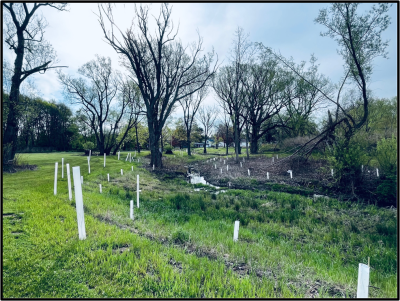Thanks to support from the Great Lakes Restoration Initiative (GLRI) through the Lake Erie Green Infrastructure Project, the City of Dunkirk, NY was recognized by the Great Lakes & St. Lawrence Cities Initiative as one of two cities to win the Wege Small Cities Sustainability Best Practices Award. The Wege Award highlights small cities, with populations of under 100,000 and with limited resources, who demonstrate leadership in tackling water quality issues while ensuring economic vitality and social equity. This award specifically recognizes meaningful projects that balance economic, social, and environmental aspects of protecting water quality that could be used as a best practice inspiration for other cities. In addition to being recognized as a winner of the Wege Award, the City of Dunkirk received a $3,750 award.
In 2022, the City of Dunkirk partnered with the Lake Erie Watershed Protection Alliance (LEWPA) and Chautauqua County Soil and Water Conservation District (SWCD) on the Lake Erie Green Infrastructure Project. Dunkirk’s project focuses on stormwater runoff from Hyde Creek onto the Wright Park Beaches and a stormwater outfall onto Main Street Beach. The Wright Park part of the project offers an opportunity to restore a wetland ecosystem adjacent to the open water of Lake Erie at Wright Park and address the flooding concerns at Wright Park Boulevard, while providing benefits to the bathing beaches of Wright Park. The Main Street Beach part of the project will re-route stormwater into an engineered wetland in an area of the Dunkirk Harbor where invasive knotweed and phragmites will be eradicated from the site and the new engineered wetland will be planted with native species.
The Wright Park and Main Street beaches are important amenities within the City of Dunkirk. The green infrastructure practices for this project were developed and designed with City of Dunkirk input to ensure that the look of the green infrastructure practices will be aesthetically pleasing once constructed.
The project applies green infrastructure practices to a combined 235-acre area and will help slow the flow of over 46,000,000 gallons of untreated stormwater runoff annually, which will reduce sediment and pollutant input into the Great Lakes system and reduce algal blooms in nearshore areas, as well as improve the habitat for fish, wildlife, and pollinators.


